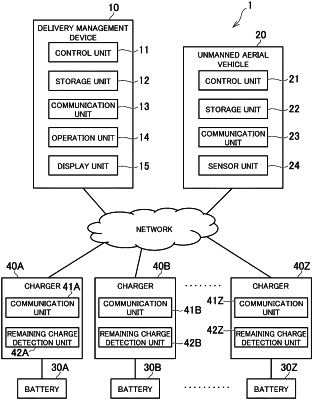| CPC G05D 1/0088 (2013.01) [B64C 39/02 (2013.01); B64D 27/24 (2013.01); B64U 50/19 (2023.01)] | 15 Claims |

|
1. A battery installation system, comprising at least one processor configured to:
acquire remaining charge information on a remaining charge of each of a plurality of batteries which are installable in an unmanned aerial vehicle;
acquire battery weight information on a weight of each battery;
acquire location information on a movement destination of the unmanned aerial vehicle;
acquire remaining charge prediction information on each of a plurality of batteries being charged wherein the remaining charge prediction information is an amount of charge in a given battery based on a time until the given battery is to be installed in the unmanned aerial vehicle;
select, based on the remaining charge information, the battery weight information, the location information, and the remaining charge prediction information, from among the plurality of batteries, a battery having a remaining charge equal to or more than a battery consumption amount for moving to the movement destination; and
execute processing for installing the selected battery in the unmanned aerial vehicle;
wherein the processing is processing of outputting identification information on the selected battery and identification information on a package to be transported by the unmanned aerial vehicle in association with each other;
instruct the unmanned aerial vehicle to deliver the package;
wherein the unmanned aerial vehicle delivers the package; and
wherein the remaining charge prediction information is acquired by multiplying an amount of increase in a remaining charge per unit time period by a time period from a current point in time until the time the given battery is to be installed in the unmanned aerial vehicle.
|